Enhancing Maize Yield and Resource Efficiency through Controlled-Release Nitrogen Fertilization on the Semiarid Loess Plateau
Abstract
:1. Introduction
2. Materials and Methods
2.1. Site Description
2.2. Experimental Design
2.3. Sampling and Measurements
2.4. Data Analysis
3. Results
3.1. Weather Condition
3.2. Effect of Controlled-Release N Fertilization on Soil Water Content and Evapotranspiration
3.3. Effect of Controlled-Release N Fertilization on Soil Enzyme Activity and Soil Nitrogen Content
3.4. Effect of Controlled-Release N Fertilization on Chlorophyll Content and Dry Matter Accumulation and Remobilization
3.5. Effect of Controlled-Release N Fertilization on Yield and Water Use Efficiency
3.6. Effect of Controlled-Release N Fertilization on Nitrogen Use Efficiency
4. Discussion
4.1. Effect of Controlled-Release N Fertilization on Soil Enzyme Activities, Biomass Accumulation, and Grain Yield
4.2. Effect of Controlled-Release N Fertilization on Water and Nitrogen Use Efficiency
5. Conclusions
Author Contributions
Funding
Data Availability Statement
Acknowledgments
Conflicts of Interest
References
- Deng, X.; Shan, L.; Zhang, H.; Turner, N.C. Improving agricultural water use efficiency in arid and semiarid areas of China. Agric. Water Manag. 2006, 80, 23–40. [Google Scholar] [CrossRef]
- Guo, L.; Ning, T.; Nie, L.; Li, Z.; Lal, R. Interaction of deep placed controlled-release urea and water retention agent on nitrogen and water use and maize yield. Eur. J. Agron. 2016, 75, 118–129. [Google Scholar] [CrossRef]
- Lal, R. Climate-strategic agriculture and the water-soil-waste nexus. J. Plant Nutr. Soil Sci. 2013, 176, 479–493. [Google Scholar] [CrossRef]
- Wang, L.; Palta, J.A.; Chen, W.; Chen, Y.; Deng, X. Nitrogen fertilization improved water-use efficiency of winter wheat through increasing water use during vegetative rather than grain filling. Agric. Water Manag. 2018, 197, 41–53. [Google Scholar]
- Huang, G.; Chen, W.; Li, F. Rainfed farming systems in the Loess Plateau of China. In Rainfed Farming System; Tow, P., Cooper, I., Partridge, I., Birch, C., Eds.; Springer: Dordrecht, The Netherlands, 2011; pp. 643–669. [Google Scholar]
- Yang, X.; Li, P.; Zhang, S.; Sun, B.; Xinping, C. Long-term-fertilization effects on soil organic carbon, physical properties, and wheat yield of a loess soil. J. Plant Nutr. Soil Sci. 2011, 174, 775–784. [Google Scholar] [CrossRef]
- Peng, Z.; Wang, L.; Xie, J.; Li, L.; Coulter, J.A.; Zhang, R.; Luo, Z.; Cai, L.; Carberry, P.; Whitbread, A. Conservation tillage increases yield and precipitation use efficiency of wheat on the semi-arid Loess Plateau of China. Agric. Water Manag. 2020, 231, 106024. [Google Scholar]
- Wang, L.; Zechariah, E.; Fudjoe, S.K.; Li, L.; Xie, J.; Luo, Z.; Cai, L.; Khan, S.; Xu, W.; Chen, Y. Continuous maize cultivation with high nitrogen fertilizers associated with the formation of dried soil layers in the semiarid farmland on the Loess Plateau. J. Hydrol. 2022, 613, 128324. [Google Scholar]
- Godfray, H.C.J.; Beddington, J.R.; Crute, I.R.; Haddad, L.; Lawrence, D.; Muir, J.F.; Pretty, J.; Robinson, S.; Thomas, S.M.; Toulmin, C. Food security: The challenge of feeding 9 billion people. Science 2010, 327, 812–818. [Google Scholar]
- Zhang, W.; Liang, Z.; He, X.; Wang, X.; Shi, X.; Zou, C.; Chen, X. The effects of controlled release urea on maize productivity and reactive nitrogen losses: A meta-analysis. Environ. Pollut. 2019, 246, 559–565. [Google Scholar]
- Chen, X.; Cui, Z.; Fan, M.; Vitousek, P.; Zhao, M.; Ma, W.; Wang, Z.; Zhang, W.; Yan, X.; Yang, J.; et al. Producing more grain with lower environmental costs. Nature 2014, 514, 486–489. [Google Scholar] [CrossRef]
- Ju, X.-T.; Xing, G.-X.; Chen, X.-P.; Zhang, S.-L.; Zhang, L.-J.; Liu, X.-J.; Cui, Z.-L.; Yin, B.; Christie, P.; Zhu, Z.-L.; et al. Reducing environmental risk by improving N management in intensive Chinese agricultural systems. Proc. Natl. Acad. Sci. USA 2009, 106, 3041–3046. [Google Scholar] [CrossRef] [PubMed]
- Abdo, A.I.; Shi, D.; Li, J.; Yang, T.; Wang, X.; Li, H.; Abdel-Hamed, E.M.; Merwad, A.-R.M.; Wang, L. Ammonia emission from staple crops in China as response to mitigation strategies and agronomic conditions: Meta-analytic study. J. Clean. Prod. 2021, 279, 123835. [Google Scholar]
- Wang, L.; Coulter, J.A.; Li, L.; Luo, Z.; Chen, Y.; Deng, X.; Xie, J. Plastic mulching reduces nitrogen footprint of food crops in China: A meta-analysis. Sci. Total Environ. 2020, 748, 141479. [Google Scholar] [PubMed]
- Huang, J.; Xu, C.-C.; Ridoutt, B.G.; Wang, X.-C.; Ren, P.-A. Nitrogen and phosphorus losses and eutrophication potential associated with fertilizer application to cropland in China. J. Clean. Prod. 2017, 159, 171–179. [Google Scholar]
- Bai, J.; Li, Y.; Zhang, J.; Xu, F.; Bo, Q.; Wang, Z.; Li, Z.; Li, S.; Shen, Y.; Yue, S. Straw returning and one-time application of a mixture of controlled release and solid granular urea to reduce carbon footprint of plastic film mulching spring maize. J. Clean. Prod. 2021, 280, 124478. [Google Scholar]
- Wang, S.; Luo, S.; Li, X.; Yue, S.; Shen, Y.; Li, S. Effect of split application of nitrogen on nitrous oxide emissions from plastic mulching maize in the semiarid Loess Plateau. Agric. Ecosyst. Environ. 2016, 220, 21–27. [Google Scholar] [CrossRef]
- Xie, J.; Wang, L.; Li, L.; Coulter, J.A.; Chai, Q.; Zhang, R.; Luo, Z.; Carberry, P.; Rao, K. Subsoiling increases grain yield, water use efficiency, and economic return of maize under a fully mulched ridge-furrow system in a semiarid environment in China. Soil Tillage Res. 2020, 199, 104584. [Google Scholar]
- Xie, J.; Wang, L.; Li, L.; Anwar, S.; Luo, Z.; Fudjoe, S.K.; Meng, H. Optimal Nitrogen Rate Increases Water and Nitrogen Use Efficiencies of Maize under Fully Mulched Ridge–Furrow System on the Loess Plateau. Agriculture 2022, 12, 1799. [Google Scholar] [CrossRef]
- Li, T.; Zhang, W.; Yin, J.; Chadwick, D.; Norse, D.; Lu, Y.; Liu, X.; Chen, X.; Zhang, F.; Powlson, D.; et al. Enhanced-efficiency fertilizers are not a panacea for resolving the nitrogen problem. Glob. Change Biol. 2018, 24, e511–e521. [Google Scholar] [CrossRef]
- Azeem, B.; KuShaari, K.; Man, Z.B.; Basit, A.; Thanh, T.H. Review on materials & methods to produce controlled release coated urea fertilizer. J. Control. Release 2014, 181, 11–21. [Google Scholar]
- Payne, K.M.; Hancock, D.W.; Cabrera, M.L.; Lacy, R.C.; Kissel, D.E. Blending polymer-coated nitrogen fertilizer improved bermudagrass forage production. Crop Sci. 2015, 55, 2918–2928. [Google Scholar] [CrossRef]
- Geng, J.; Chen, J.; Sun, Y.; Zheng, W.; Tian, X.; Yang, Y.; Li, C.; Zhang, M. Controlled release urea improved nitrogen use efficiency and yield of wheat and corn. Agron. J. 2016, 108, 1666–1673. [Google Scholar] [CrossRef]
- Hu, H.; Ning, T.; Li, Z.; Han, H.; Zhang, Z.; Qin, S.; Zheng, Y. Coupling effects of urea types and subsoiling on nitrogen–water use and yield of different varieties of maize in northern China. Field Crops Res. 2013, 142, 85–94. [Google Scholar] [CrossRef]
- Yao, Z.; Zhang, W.; Wang, X.; Zhang, L.; Zhang, W.; Liu, D.; Chen, X. Agronomic, environmental, and ecosystem economic benefits of controlled-release nitrogen fertilizers for maize production in Southwest China. J. Clean. Prod. 2021, 312, 127611. [Google Scholar] [CrossRef]
- Hu, H.; Ning, T.; Li, Z.; Han, H.; Zhang, Z.; Qin, S.; Zheng, Y. Improving crop yields, nitrogen use efficiencies, and profits by using mixtures of coated controlled-released and uncoated urea in a wheat-maize system. Field Crops Res. 2017, 205, 106–115. [Google Scholar]
- Guo, J.; Wang, Y.; Blaylock, A.D.; Chen, X. Mixture of controlled release and normal urea to optimize nitrogen management for high-yielding (>15 Mg ha−1) maize. Field Crops Res. 2017, 204, 23–30. [Google Scholar] [CrossRef]
- Kaur, G.; Zurweller, B.A.; Nelson, K.A.; Motavalli, P.P.; Dudenhoeffer, C.J. Soil waterlogging and nitrogen fertilizer management effects on corn and soybean yields. Agron. J. 2017, 109, 97–106. [Google Scholar] [CrossRef]
- Rubin, J.C.; Struffert, A.M.; Fernández, F.G.; Lamb, J.A. Maize yield and nitrogen use efficiency in upper midwest irrigated sandy soils. Agron. J. 2016, 108, 1681–1691. [Google Scholar] [CrossRef]
- Yu, H.; Tremblay, N.; Wang, Z.; Bélec, C.; Yang, G.; Grant, C. Evaluation of Nitrogen Sources and Application Methods for Nitrogen-Rich Reference Plot Establishment in Corn. Agron. J. 2010, 102, 23–30. [Google Scholar] [CrossRef]
- Li, T.; Liu, J.; Wang, S.; Zhang, Y.; Zhan, A.; Li, S. Maize yield response to nitrogen rate and plant density under film mulching. Agron. J. 2018, 110, 996–1007. [Google Scholar] [CrossRef]
- Gong, Z. Chinese Soil Taxonomy; Science Press: Beijing, China, 2001. [Google Scholar]
- del Carmen Cuevas-Díaz, M.; Martínez-Toledo, Á.; Guzmán-López, O.; Torres-López, C.P.; del C Ortega-Martínez, A.; Hermida-Mendoza, L.J. Catalase and phosphatase activities during hydrocarbon removal from oil-contaminated soil amended with agro-industrial by-products and macronutrients. Water Air Soil Pollut. 2017, 228, 159. [Google Scholar] [CrossRef]
- Jin, K.; Sleutel, S.; Buchan, D.; De Neve, S.; Cai, D.; Gabriels, D.; Jin, J. Changes of soil enzyme activities under different tillage practices in the Chinese Loess Plateau. Soil Tillage Res. 2009, 104, 115–120. [Google Scholar] [CrossRef]
- Abdelmagid, H.; Tabatabai, M. Nitrate reductase activity of soils. Soil Biol. Biochem. 1987, 19, 421–427. [Google Scholar] [CrossRef]
- Barro, F.; Fontes, A.G.; Maldonado, J.M. Organic nitrogen content and nitrate and nitrite reductase activities in tritordeum and wheat grown under nitrate or ammonium. Plant Soil 1991, 135, 251–256. [Google Scholar] [CrossRef]
- Arduini, I.; Masoni, A.; Ercoli, L.; Mariotti, M. Grain yield, and dry matter and nitrogen accumulation and remobilization in durum wheat as affected by variety and seeding rate. Eur. J. Agron. 2006, 25, 309–318. [Google Scholar] [CrossRef]
- Wang, L.; Wang, S.; Chen, W.; Li, H.; Deng, X. Physiological mechanisms contributing to increased water-use efficiency in winter wheat under organic fertilization. PLoS ONE 2017, 12, e0180205. [Google Scholar] [CrossRef]
- Pérez-Guzmán, L.; Acosta-Martínez, V.; Phillips, L.A.; Mauget, S.A. Resilience of the microbial communities of semiarid agricultural soils during natural climatic variability events. Appl. Soil Ecol. 2020, 149, 103487. [Google Scholar] [CrossRef]
- Wang, X.; Wang, G.; Guo, T.; Xing, Y.; Mo, F.; Wang, H.; Fan, J.; Zhang, F. Effects of plastic mulch and nitrogen fertilizer on the soil microbial community, enzymatic activity and yield performance in a dryland maize cropping system. Eur. J. Soil Sci. 2021, 72, 400–412. [Google Scholar] [CrossRef]
- Ji, P.; Peng, Y.; Cui, Y.; Li, X.; Tao, P.; Zhang, Y. Effects of reducing and postponing controlled-release urea application on soil nitrogen regulation and maize grain yield. Int. J. Agric. Biol. Eng. 2022, 15, 116–123. [Google Scholar] [CrossRef]
- Yang, J.; Zhang, J.; Liu, L.; Wang, Z.; Zhu, Q. Carbon remobilization and grain filling in Japonica/Indica hybrid rice subjected to postanthesis water deficits. Agron. J. 2002, 94, 102–109. [Google Scholar] [CrossRef]
- Kang, S.; Shi, W.; Zhang, J. An improved water-use efficiency for maize grown under regulated deficit irrigation. Field Crops Res. 2000, 67, 207–214. [Google Scholar] [CrossRef]
- Turner, N.C. Agronomic options for improving rainfall-use efficiency of crops in dryland farming systems. J. Exp. Bot. 2004, 55, 2413–2425. [Google Scholar] [CrossRef] [PubMed]
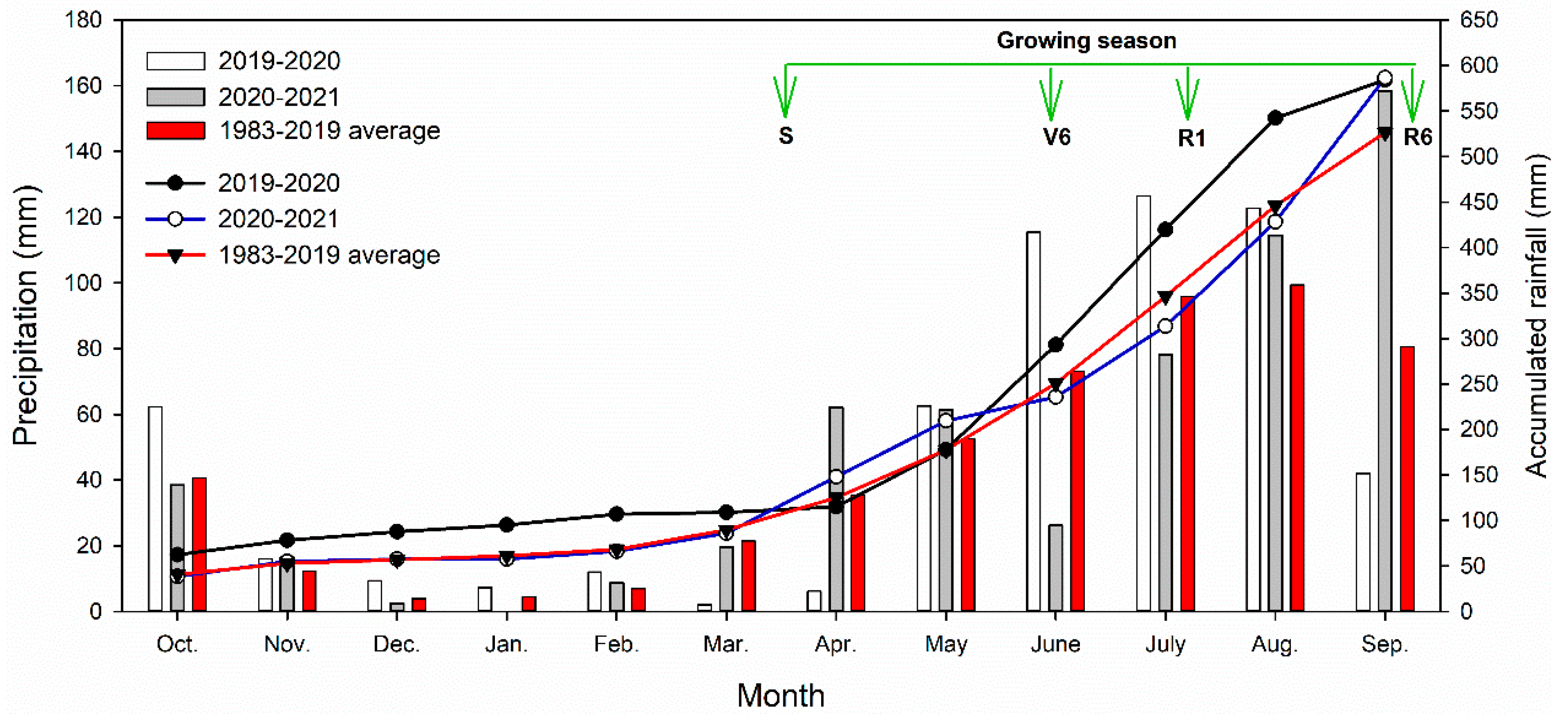
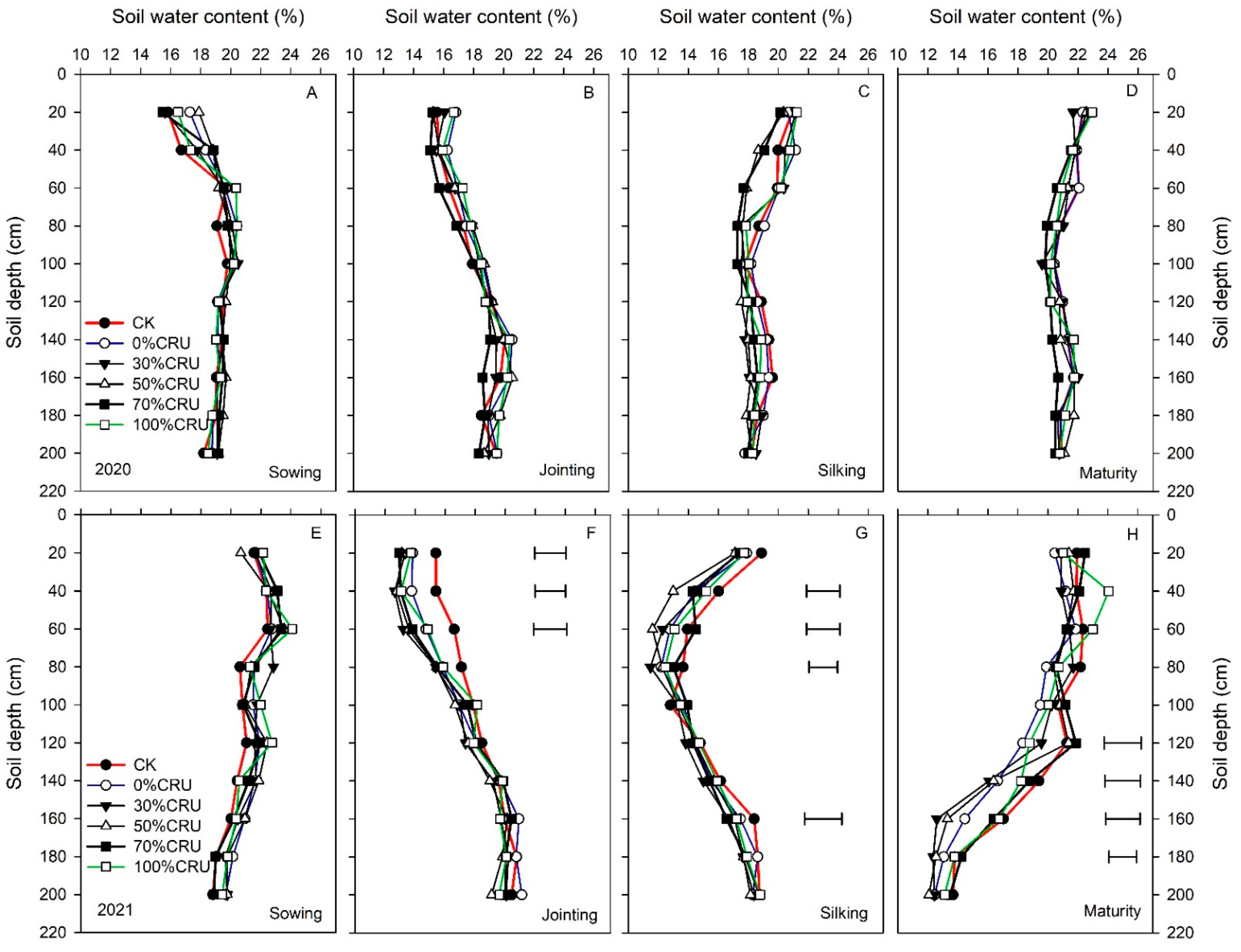
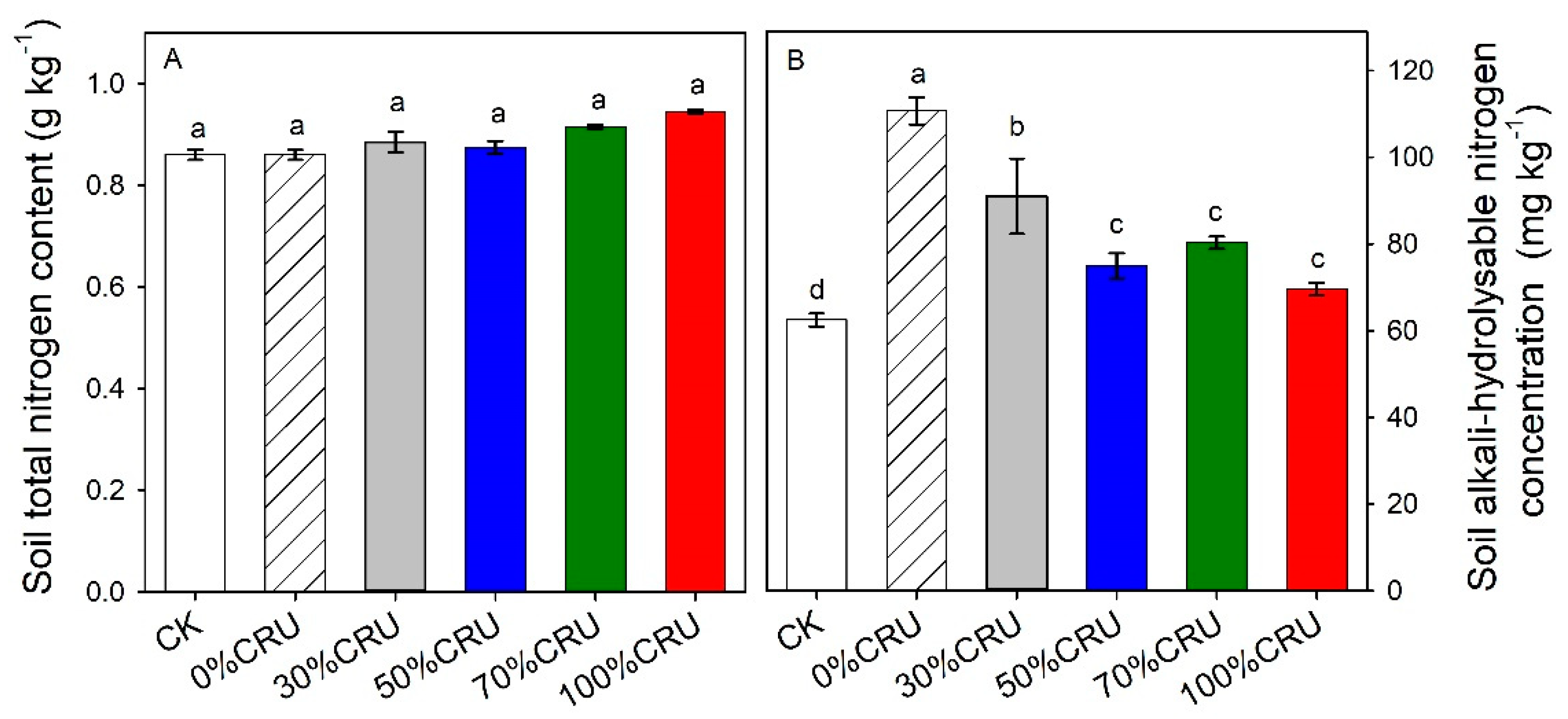
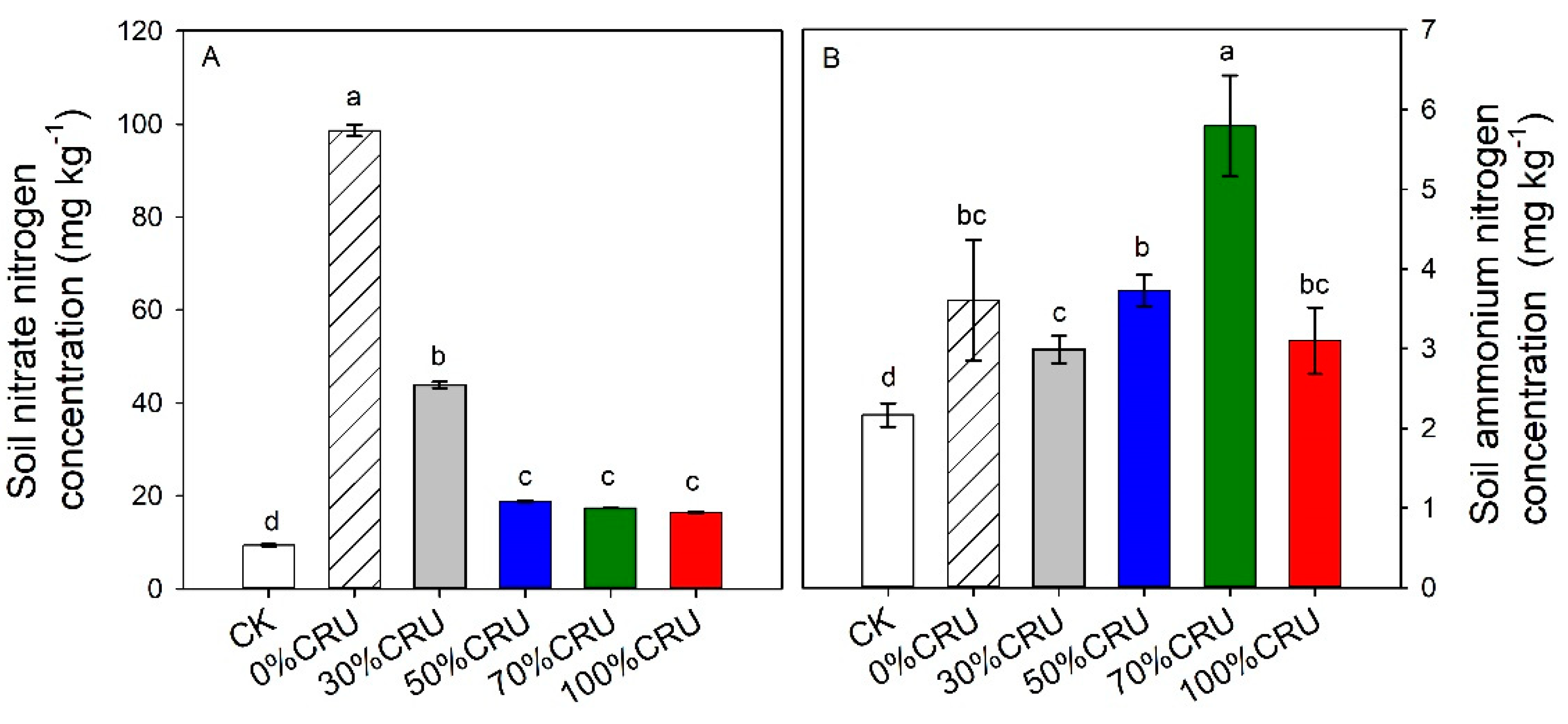
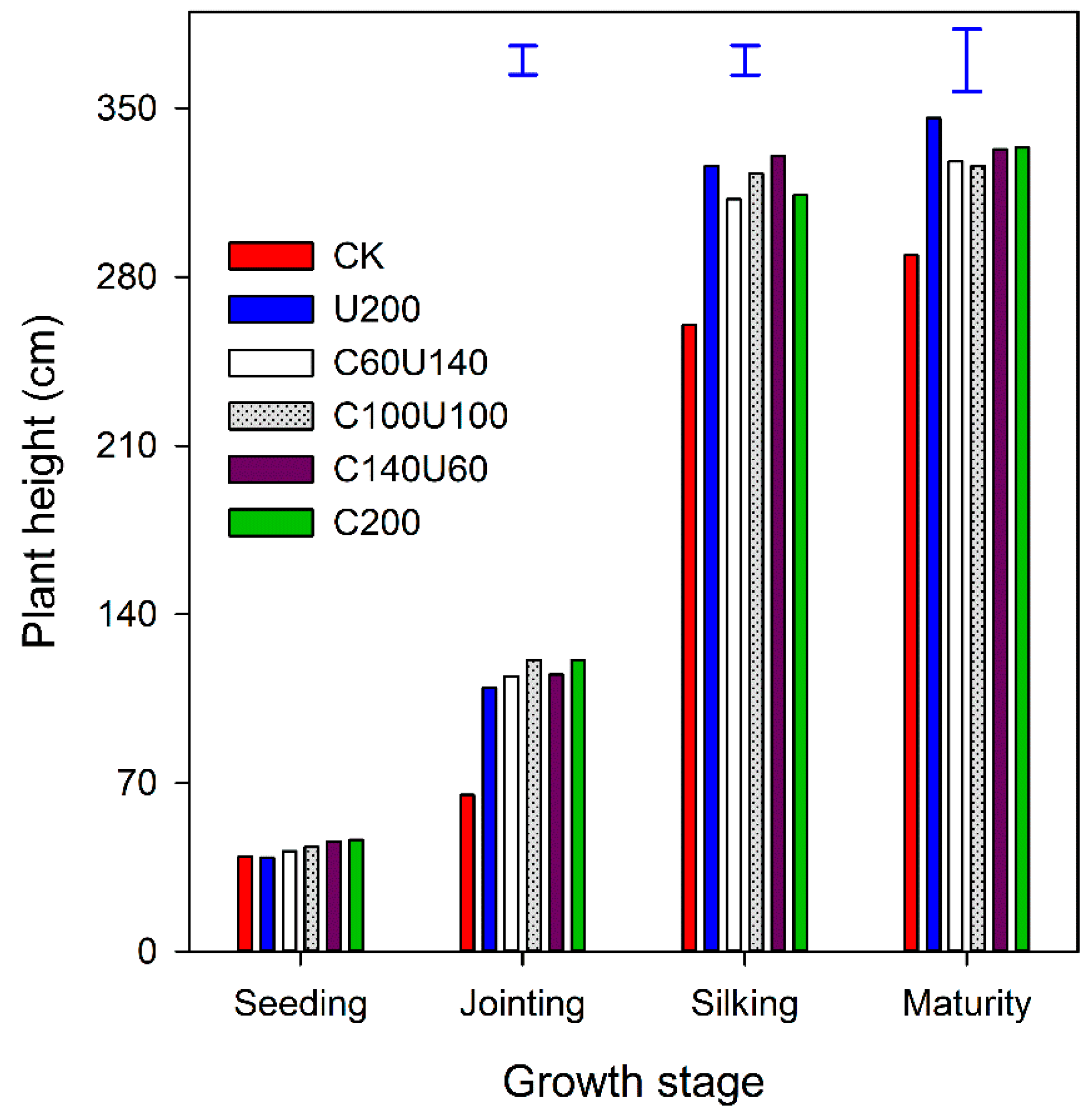
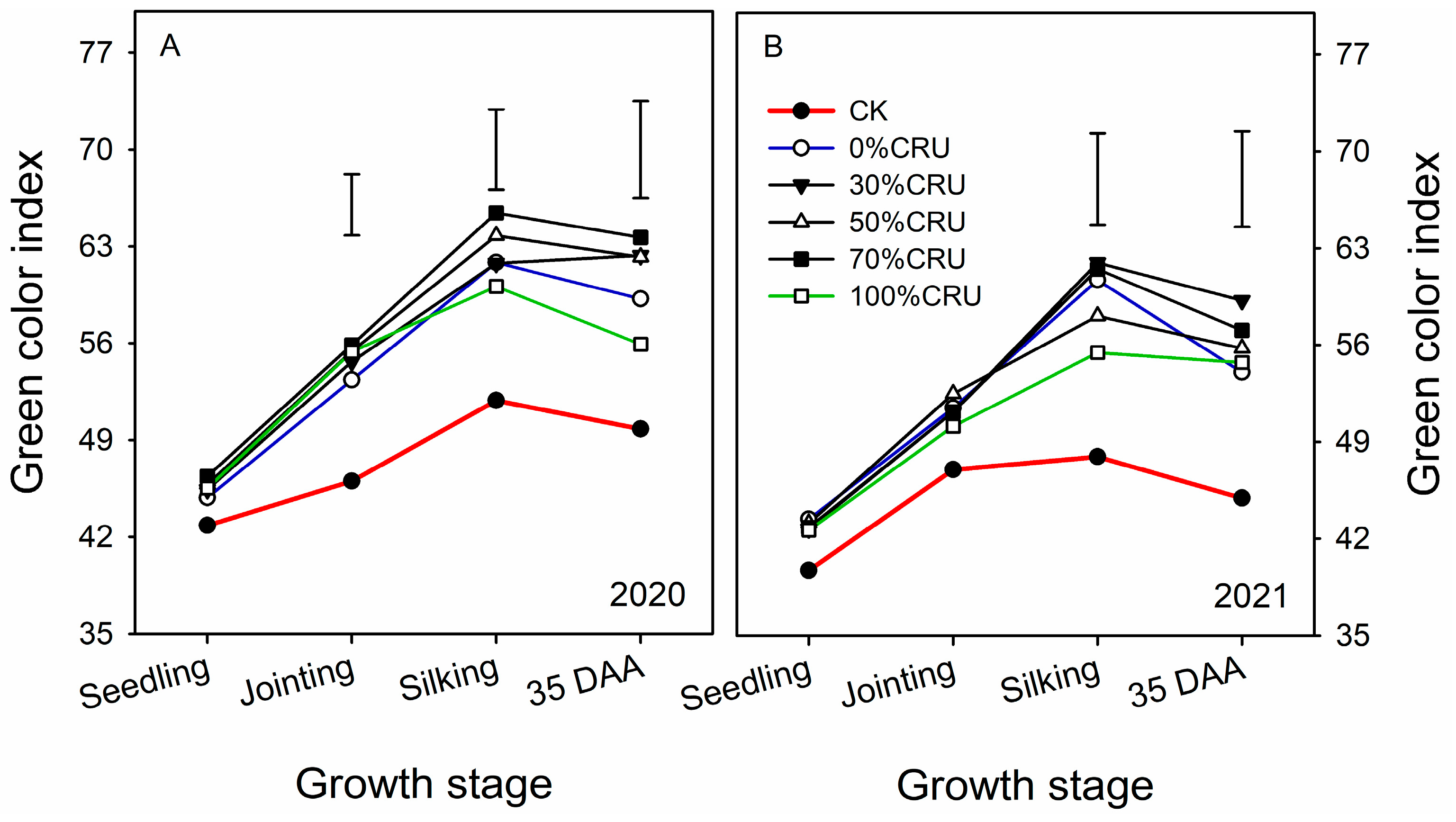
| Treatment | Total N Fertilization Rate (kg N ha−1) | P2O5 | |
|---|---|---|---|
| CRU-N | Common Urea-N | kg ha−1 | |
| CK | 0 | 0 | 120 |
| 0%CRU | 0 | 225 | 120 |
| 30%CRU | 67.5 | 157.5 | 120 |
| 50%CRU | 112.5 | 112.5 | 120 |
| 70%CRU | 157.5 | 67.5 | 120 |
| 100%CRU | 225 | 0 | 120 |
| Year | Annual Rainfall | DI 1 for | Soil Water Condition | Fallow Period | DI for Fallow | Soil Water Condition | Seasonal Rainfall | DI for | Soil Water Condition |
|---|---|---|---|---|---|---|---|---|---|
| (mm) | Annual Rainfall | for Annual Rainfall | Rainfall (mm) | Period Rainfall | for Fallow Period Rainfall | (mm) | Seasonal Rainfall | for Seasonal Rainfall | |
| 2020 | 565.3 | 0.241 | Normal | 115.1 | −0.26 | Normal | 450.2 | 0.48 | Wet |
| 2021 | 549.7 | 0.09 | Normal | 148.0 | 0.61 | Wet | 401.7 | −0.04 | Normal |
| Mean (1970–2019) | 540.0 | – | – | 125.0 | – | – | 405.5 | – | – |
| Year | Treatment | Evapotranspiration (mm) | |||
|---|---|---|---|---|---|
| Sowing–Jointing | Jointing–Silking | Silking–Maturity | Sum | ||
| 2020 | CK | 98.2 b 1 | 148.5 b | 138.6 a | 385.3 c |
| 0%CRU | 89.7 bc | 157.5 ab | 145.1 a | 392.2 c | |
| 30%CRU | 105.5 ab | 161.7 ab | 130.2 a | 397.5 bc | |
| 50%CRU | 105.9 ab | 170.1 a | 149.4 a | 425.5 ab | |
| 70%CRU | 116.8 a | 176.3 a | 148.9 a | 442.2 a | |
| 100%CRU | 86.1 c | 168.1 ab | 133.4 a | 387.7 c | |
| 2021 | CK | 149.8 c | 106.9 ab | 56.0 b | 312.7 b |
| 0%CRU | 176.3 bc | 116.1 a | 81.2 a | 373.6 a | |
| 30%CRU | 204.6 a | 101.7 ab | 67.9 ab | 374.2 a | |
| 50%CRU | 204.7 a | 88.5 b | 70.4 ab | 363.5 a | |
| 70%CRU | 193.8 ab | 86.8 b | 62.9 ab | 343.5 ab | |
| 100%CRU | 195.0 ab | 98.3 ab | 53.9 b | 347.2 ab | |
| Average | CK | 124.0 b | 127.7 a | 97.3 ab | 349.0 b |
| 0%CRU | 133.0 b | 136.8 a | 113.2 a | 382.9 a | |
| 30%CRU | 155.1 a | 131.7 a | 99.0 ab | 385.9 a | |
| 50%CRU | 155.3 a | 129.3 a | 109.9 ab | 394.5 a | |
| 70%CRU | 155.4 a | 131.5 a | 105.9 ab | 392.9 a | |
| 100%CRU | 140.6 ab | 133.2 a | 93.7 b | 367.5 ab | |
| Treatment | Soil Enzyme Activities | ||||
|---|---|---|---|---|---|
| Urease | Nitrate Reductase | Nitrite Reductase | Sucrase | Catalase | |
| µg NH4+-N d−1 g−1 soi | µg NO2−-N d−1 g−1 soi | µmol NO2−-N d−1 g−1 soi | mg Glucose d−1 g−1 soil | mmol H2O2 d−1 g−1 soi | |
| CK | 542.86 b 1 | 3.03 d | 3.14 e | 27.28 ab | 58.33 a |
| 0%CRU | 577.01 ab | 4.73 ab | 3.61 de | 29.70 a | 59.34 a |
| 30%CRU | 586.13 ab | 3.39 d | 5.94 b | 30.56 a | 63.22 a |
| 50%CRU | 595.83 ab | 3.90 c | 4.80 c | 27.91 ab | 62.55 a |
| 70%CRU | 611.79 ab | 4.64 b | 4.14 d | 25.00 b | 61.94 a |
| 100%CRU | 618.99 a | 5.28 a | 6.64 a | 29.18 ab | 59.45 a |
| Year | Treatment | Biomass Accumulation (kg ha–1) | ||||
|---|---|---|---|---|---|---|
| Seedling Stage | Jointing Stage | Silking Stage | Milk Ripening Stage | Maturity Stage | ||
| 2020 | CK | 365 c 1 | 2143 b | 16,571 b | 20,483 c | 25,500 b |
| 0%CRU | 415 bc | 2470 b | 15,964 b | 22,525 b | 26,378 b | |
| 30%CRU | 378 c | 2495 b | 16,639 b | 23,370 ab | 26,688 b | |
| 50%CRU | 488 b | 2605 ab | 16,804 b | 23,570 ab | 26,915 b | |
| 70%CRU | 590 a | 3110 a | 17,786 a | 24,590 a | 29,210 a | |
| 100%CRU | 485 b | 2690 ab | 17,449 a | 22,853 b | 26,558 b | |
| 2021 | CK | 318 b | 1981 b | 12,275 c | 15,670 d | 18,100 c |
| 0%CRU | 351 ab | 2297 ab | 17,146 b | 21,697 c | 30,800 b | |
| 30%CRU | 345 b | 2289 ab | 17,871 b | 24,180 b | 31,850 b | |
| 50%CRU | 381 ab | 2393 ab | 18,049 ab | 24,693 ab | 31,950 b | |
| 70%CRU | 402 a | 2594 a | 19,104 a | 26,978 a | 34,575 a | |
| 100%CRU | 367 ab | 2168 ab | 18,741 ab | 25,991 ab | 32,975 ab | |
| Average | CK | 342 b | 2062 b | 14,423 c | 18,077 d | 21,800 c |
| 0%CRU | 383 b | 2384 ab | 16,555 b | 22,111 c | 28,589 b | |
| 30%CRU | 362 b | 2392 ab | 17,255 ab | 23,775 bc | 29,269 ab | |
| 50%CRU | 435 ab | 2499 ab | 17,427 ab | 24,132 ab | 29,433 ab | |
| 70%CRU | 496 a | 2852 a | 18,445 a | 25,784 a | 31,893 a | |
| 100%CRU | 426 ab | 2429 ab | 18,095 a | 24,422 ab | 29,767 ab | |
| Year | Treatment | DMR | CDMR | PDM | CPDM |
|---|---|---|---|---|---|
| kg ha−1 | (%) | kg ha−1 | (%) | ||
| 2020 | CK | 2691 c 1 | 23.2 bc | 8929 c | 76.8 ab |
| 0%CRU | 2065 d | 16.5 c | 10,414 b | 83.5 a | |
| 30%CRU | 3306 c | 24.8 b | 10,049 b | 75.2 ab | |
| 50%CRU | 4055 b | 28.6 ab | 10,111 ab | 71.4 bc | |
| 70%CRU | 4806 a | 29.6 ab | 11,424 a | 70.4 bc | |
| 100%CRU | 4205 ab | 31.6 a | 9109 bc | 68.4 c | |
| 2021 | CK | 4131 a | 41.5 a | 5825 c | 58.5 c |
| 0%CRU | 1544 c | 10.2 bc | 13,654 b | 89.8 ab | |
| 30%CRU | 1808 c | 11.5 bc | 13,979 b | 88.5 ab | |
| 50%CRU | 2760 b | 16.6 b | 13,901 b | 83.4 b | |
| 70%CRU | 1534 c | 9.0 c | 15,471 a | 91.0 a | |
| 100%CRU | 1715 c | 10.8 bc | 14,234 ab | 89.2 ab | |
| Average | CK | 3411 a | 32.4 a | 7377 c | 67.7 c |
| 0%CRU | 1805 d | 13.4 c | 12,034 b | 86.7 a | |
| 30%CRU | 2557 c | 18.2 bc | 12,014 b | 81.9 ab | |
| 50%CRU | 3408 a | 22.6 b | 12,006 b | 77.4 b | |
| 70%CRU | 3170 ab | 19.3 b | 13,448 a | 80.7 ab | |
| 100%CRU | 2960 b | 21.2 b | 11,672 b | 78.8 b |
| Year | Treatment | Grain No. per Ear | 100-Grain Weight | Grain Yield | HI |
|---|---|---|---|---|---|
| (g) | kg ha−1 | (%) | |||
| 2020 | CK | 611.3 c 1 | 29.4 b | 11,620 d | 45.6 d |
| 0%CRU | 630.4 b | 31.6 ab | 12,479 cd | 47.3 c | |
| 30%CRU | 642.4 ab | 30.8 ab | 13,355 bc | 50.0 b | |
| 50%CRU | 654.8 ab | 33.2 ab | 14,166 b | 52.6 b | |
| 70%CRU | 668.2 a | 34.5 a | 16,230 a | 55.6 a | |
| 100%CRU | 647.1 ab | 33.0 ab | 13,314 bc | 50.1 b | |
| 2021 | CK | 464.9 c | 29.0 b | 9956 c | 55.0 a |
| 0%CRU | 601.2 b | 32.3 ab | 15,198 bc | 49.3 c | |
| 30%CRU | 602.1 b | 34.9 ab | 15,787 b | 49.6 c | |
| 50%CRU | 642.7 ab | 34.3 ab | 16,661 ab | 52.1 b | |
| 70%CRU | 652.3 a | 35.8 a | 17,006 a | 49.2 c | |
| 100%CRU | 616.5 ab | 33.5 ab | 15,949 b | 48.4 c | |
| Average | CK | 538.1 d | 29.2 b | 10,788 c | 49.5 b |
| 0%CRU | 615.8 c | 32.0 ab | 13,839 bc | 48.4 b | |
| 30%CRU | 622.3 bc | 32.9 ab | 14,571 b | 49.8 ab | |
| 50%CRU | 648.8 ab | 33.8 ab | 15,414 ab | 52.4 a | |
| 70%CRU | 660.3 a | 35.2 a | 16,618 a | 52.1 a | |
| 100%CRU | 631.8 abc | 33.3 ab | 14,632 b | 49.2 b |
| Year | Treatment | WUEb (kg ha−1 mm−1) | WUEg | ||
|---|---|---|---|---|---|
| Sowing–Jointing | Jointing–Silking | Silking–Maturity | kg ha−1 mm−1 | ||
| 2020 | CK | 21.8 c 1 | 97.2 a | 64.4 c | 30.1 c |
| 0%CRU | 27.5 ab | 85.7 b | 71.8 ab | 31.9 bc | |
| 30%CRU | 23.6 b | 87.5 b | 77.2 a | 33.6 b | |
| 50%CRU | 24.6 b | 83.5 b | 67.7 bc | 33.3 b | |
| 70%CRU | 26.6 b | 83.2 b | 76.7 a | 36.7 a | |
| 100%CRU | 31.2 a | 87.8 b | 68.3 bc | 34.4 ab | |
| 2021 | CK | 13.2 a | 96.3 d | 104.1 d | 22.6 c |
| 0%CRU | 13.0 a | 127.9 c | 168.1 c | 26.4 bc | |
| 30%CRU | 11.2 b | 153.2 b | 205.9 b | 27.3 b | |
| 50%CRU | 11.7 b | 176.9 b | 197.5 b | 30.5 ab | |
| 70%CRU | 13.4 a | 190.3 a | 245.8 a | 32.9 a | |
| 100%CRU | 11.1 b | 168.6 b | 264.0 a | 29.1 ab | |
| Average | CK | 16.6 bc | 96.8 b | 75.8 c | 30.9 c |
| 0%CRU | 17.9 ab | 103.6 ab | 106.4 b | 36.1 b | |
| 30%CRU | 15.4 c | 112.9 a | 121.3 ab | 37.8 b | |
| 50%CRU | 16.1 bc | 115.4 a | 109.2 b | 39.1 ab | |
| 70%CRU | 18.4 a | 118.5 a | 127.0 a | 42.3 a | |
| 100%CRU | 17.3 ab | 117.6 a | 124.6 ab | 39.8 ab | |
| Year | Treatment | AEN | ANR | PhEN |
|---|---|---|---|---|
| kg kg−1 | % | kg kg−1 | ||
| 2020 | CK | − | − | − |
| 0%CRU | 3.8 d 1 | 26.1 d | 14.6 e | |
| 30%CRU | 7.7 c | 29.7 c | 26.0 c | |
| 50%CRU | 11.3 b | 33.3 bc | 34.0 b | |
| 70%CRU | 20.5 a | 34.5 b | 59.4 a | |
| 100%CRU | 7.5 c | 38.8 a | 19.4 d | |
| 2021 | CK | − | − | − |
| 0%CRU | 23.3 c | 32.9 d | 70.8 bc | |
| 30%CRU | 25.9 bc | 34.7 c | 74.7 b | |
| 50%CRU | 29.8 ab | 36.3 bc | 82.1 a | |
| 70%CRU | 31.3 a | 37.4 b | 83.8 a | |
| 100%CRU | 26.6 b | 39.7 a | 67.1 c | |
| Average | CK | − | − | − |
| 0%CRU | 15.3 d | 29.5 c | 46.0 cd | |
| 30%CRU | 18.9 c | 32.2 bc | 52.2 bc | |
| 50%CRU | 23.1 b | 34.8 b | 59.1 b | |
| 70%CRU | 29.2 a | 36.0 ab | 72.1 a | |
| 100%CRU | 19.2 c | 39.3 a | 43.5 d |
Disclaimer/Publisher’s Note: The statements, opinions and data contained in all publications are solely those of the individual author(s) and contributor(s) and not of MDPI and/or the editor(s). MDPI and/or the editor(s) disclaim responsibility for any injury to people or property resulting from any ideas, methods, instructions or products referred to in the content. |
© 2023 by the authors. Licensee MDPI, Basel, Switzerland. This article is an open access article distributed under the terms and conditions of the Creative Commons Attribution (CC BY) license (https://creativecommons.org/licenses/by/4.0/).
Share and Cite
Zhang, J.; Zhao, G.; Dang, Y.; Fan, T.; Wang, L.; Li, S.; Zhou, G.; Fudjoe, S.K.; Wang, L.; Palta, J.A. Enhancing Maize Yield and Resource Efficiency through Controlled-Release Nitrogen Fertilization on the Semiarid Loess Plateau. Agronomy 2023, 13, 2320. https://doi.org/10.3390/agronomy13092320
Zhang J, Zhao G, Dang Y, Fan T, Wang L, Li S, Zhou G, Fudjoe SK, Wang L, Palta JA. Enhancing Maize Yield and Resource Efficiency through Controlled-Release Nitrogen Fertilization on the Semiarid Loess Plateau. Agronomy. 2023; 13(9):2320. https://doi.org/10.3390/agronomy13092320
Chicago/Turabian StyleZhang, Jianjun, Gang Zhao, Yi Dang, Tinglu Fan, Lei Wang, Shangzhong Li, Gang Zhou, Setor Kwami Fudjoe, Linlin Wang, and Jairo A. Palta. 2023. "Enhancing Maize Yield and Resource Efficiency through Controlled-Release Nitrogen Fertilization on the Semiarid Loess Plateau" Agronomy 13, no. 9: 2320. https://doi.org/10.3390/agronomy13092320
APA StyleZhang, J., Zhao, G., Dang, Y., Fan, T., Wang, L., Li, S., Zhou, G., Fudjoe, S. K., Wang, L., & Palta, J. A. (2023). Enhancing Maize Yield and Resource Efficiency through Controlled-Release Nitrogen Fertilization on the Semiarid Loess Plateau. Agronomy, 13(9), 2320. https://doi.org/10.3390/agronomy13092320






